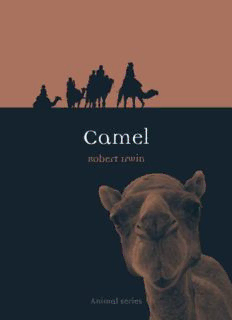
Preview Camel
Camel nimal Series editor: Jonathan Burt Already published A Crow Salmon Ape Boria Sax Peter Coates Fox John Sorenson Pigeon Martin Wallen Fly Barbara Allen Owl Ant Steven Connor Cat Desmond Morris Snail Charlotte SleighKatharine M. RogersPeter Williams Hare Tortoise Peacock Simon Carnell Penguin Peter YoungChristine E. JacksonStephen Martin Lion Cockroach Cow Deirdre Jackson Marion CopelandHannah Velten Swan Dog Peter Young Shark Susan McHughDean Crawford Oyster Rhinoceros Rebecca Stott Bear Kelly Enright Moose Robert E. Bieder Bee Kevin Jackson Duck Claire Preston Rat Victoria de Rijke Jonathan Burt Snake Drake Stutesman Falcon Helen Macdonald Whale Horse Joe Roman Elaine Walker Elephant Parrot Dan Wylie Eel Paul Carter Tiger Richard Schweid Susie Green Camel Robert Irwin REAKTION BOOKS Published by REAKTION BOOKS LTD 33 Great Sutton Street London EC1V 0DX, UK www.reaktionbooks.co.uk First published 2010 Copyright © Robert Irwin 2010 All rights reserved No part of this publication may be reproduced, stored in a retrieval system or transmitted, in any form or by any means, electronic, mechanical, photocopying, recording or otherwise without the prior permission of the publishers. Page references in the Photo Acknowledgements and Index match the printed edition of this book. Printed and bound in China by Eurasia British Library Cataloguing in Publication Data Irwin, Robert, 1946 Camel. – (Animal) 1. Camels. 2. Camels – Social aspects. 3. Camels in art. 4. Camels in literature. I. Title II. Series 599.6’362-DC2 eISBN: 9781861897343 Contents Introduction 1 Physiology and Psychology 2 Ancestors of the Camel 3 Practical Camel 4 Camels in the Medieval World of Islam 5 The Beauty of the Beast: Literature and Art 6 The Camel’s Role in History 7 Modernity’s Camel Timeline of the Camel References Select Bibliography Associations and Websites Acknowledgements Photo Acknowledgements Index Shadows of a caravan of camels cast on the desert sand. Dunhuang, province of Gansu, China. Introduction ‘Phoebe, do you believe that your favourite animal says a lot about you?’ ‘You mean behind my back?’ An exchange between Rachel Green and Phoebe Buffay in the US TV series Friends This is a book about the one-humped and two-humped camel. Throughout the book I shall be referring to the first as ‘dromedary’ and the second as ‘Bactrian’. Purists may object that strictly speaking ‘dromedary’ should refer only to a racing or pedigree camel. The nineteenth-century desert explorer William Gifford Palgrave tried to sort out the terminological confusion: The camel and the dromedary in Arabia are the same identical genus and creature, excepting that the dromedary is a high-bred camel, and the camel a low-bred dromedary, exactly the same distinction which exists between a race- horse and a hack; both are horses, but the one of blood, the other not. The dromedary is the race-horse of his species, thin, elegant (or comparatively so), fine haired, light of step, easy of pace, and much more enduring of thirst than the woolly, thick-built, heavy-footed ungainly, and jolting camel. But both and each of them have only one hump.1 ‘Dromedary’ derives ultimately from the Greek dromos, meaning ‘road’, or ‘course’. But in practice ‘dromedary’ is so widely used to refer to any kind of one-humped camel that that particular terminological battle has been lost. As for ‘Bactrian’, this refers to the region of northern Afghanistan where two- humped camels were once plentiful. (But I do not think that there are any there today.) In order to remember which camel is which, it is helpful to think of the D of dromedary as lying on its side, producing a single hump, while the B of Bactrian on its side produces two humps. ‘Le Dromadaire’ from the Comte du Buffon’s Natural History (1799–1800). This is my first book in which scientific matters are at issue. I am startled then to find how much contention, vagueness and sheer lack of research bedevils the scientific study of the camel. For example, how many stomachs has a camel got? The fascist camel vet Arnold Leese said three. The Camel Corps HMSO
Description: